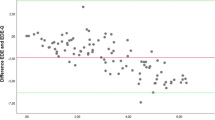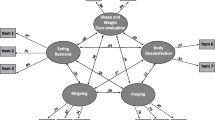Abstract
Purpose
To present normative data for the Eating Disorders Examination Questionnaire, 6th edition (EDE-Q) from a large (n = 2,448), diverse (56 % White) sample of college students.
Methods
Participants completed the EDE-Q online. Mean scores and percentile ranks for global and subscale (restraint and eating, weight, and shape concerns) scores and binge eating and inappropriate compensatory behavior (dietary restraint, self-induced vomiting, medicine misuse, excessive exercise) frequencies were computed.
Results
Women had higher global and subscale scores and tended to engage in inappropriate compensatory behaviors more often than men. Women with clinically significant restraint, and eating, shape, and weight concerns scores equaled 5.4, 2.0, 18.6, and 13.0 %, respectively, and, for men, equaled 3.0, 0.3, 6.0, and 2.0 %. Compared with less diverse samples, women in this study had significantly higher shape concern and lower restraint and eating concern scores and men had lower shape and weight concern scores.
Conclusions
Normative data from this diverse sample can help healthcare professionals and researchers better interpret EDE-Q scores.
Similar content being viewed by others
References
Fairburn C, Beglin S (1994) Assessment of eating disorders: interview or self-report questionnaire? Int J Eat Disord 16:363–370
American Psychiatric Association (2000) Diagnostic and statistical manual of psychiatric disorders, 4th edition. Washington DC
Mitchell J, Peterson C (2005) Assessment of eating disorders. Guilford Press, New York
Cooper Z, Fairburn C (1987) The eating disorder examination: a semi-structured interview for the assessment of the specific psychopathology of eating disorders. Int J Eat Disord 6:1–8
Mond J, Hay P, Rodgers B, Owen C, Beumont D (2004) Validity of the Eating Disorder Examination Questionnaire (EDE-Q) in screening for eating disorders in community samples. Behav Res Ther 42:551–567
Mond J, Hay P, Rodgers B, Owen C, Beumont P (2004) Temporal stability of the Eating Disorder Examination Questionnaire. Int J Eat Disord 36:195–203
Black C, Wilson G (1996) Interview versus questionnaire. Int J Eat Disord 20:43–50
Beglin S, Fairburn C (1992) What is meant by the term “binge”? Am J Psychiatry 149:123–124
Binford R, Le Grange D, Jellar C (2005) Eating Disorders Examination-Questionnaire in adolescents with full and partial-syndrome bulimia nervosa and anorexia nervosa. Int J Eat Disord 37:44–49
Passi V, Bryson S, Lock J (2002) Assessment of eating disorders in adolescents with anorexia nervosa: self-report questionnaire versus interview. Int J Eat Disord 33:45–54
Berg K, Peterson C, Frazier P, Crow S (2012) Psychometric evaluation of the eating disorder examination and Eating Disorder Examination-Questionnaire: a systematic review of literature. Int J Eat Disord 45(3):428–438. doi:10.1002/eat.20931
Krahn D, Kurth C, Gomberg E, Drewnowski A (2005) Pathological dieting and alcohol use in college women—a continuum of behaviors. Eat Behav 6:43–52
Lewinsohn P, Striegel-Moore R, Seeley J (2000) Epidemiology and natural course of eating disorders in young women from adolescence to young adulthood. J Am Acad Child Adolesc Psychiatry 39:11–20
Berg K, Frazier P, Sherr L (2009) Change in eating disorder attitudes and behavior in college women: prevalence and predictors. Eat Behav 10:137–142
Compas B, Wagner B, Slavin L, Vannatta K (1986) A prospective study of life events, social support, and psychological symptomatology during the transition from high school to college. Am J Commun Psychol 14:241–257
Striegel-Moore R, Silbersetin L, Frensch P, Rodin J (1989) A prospective study of disordered eating among college students. Int J Eat Disord 8(5):499–509
Becker A, Franko D, Nussbaum K, Herzog D (2004) Secondary prevention for eating disorders: the impact of education, screening and referral in a college-based screening program. Int J Eat Disord 36:157–162
Luce K, Crowther J, Pole M (2008) Eating Disorder Examination Questionnaire (EDE-Q): norms for undergraduate women. Int J Eat Disord 41:273–276
Lavender J, De Young K, Anderson D (2010) Eating Disorder Examination Questionnaire (EDE-Q): norms for undergraduate men. Eat Behav 11:119–121
Fairburn C, Cooper Z, O’Connor M (2008) Cognitive behavior therapy and eating disorders. Guilford Press, New York
National Center for Health Statistics (NCHC) (1999–2004) National Health and Nutrition Examination Questionnaire III. Services DoHaH, Centers for Disease Control and Prevention (CDC), Hyattsville, MD
Paolo A, Bonaminio G, Gibson C, Patridge T, Kallail K (2000) Response rate comparisons of email and mail distributed student evaluations. Teach Learn Med 12(2):81–84
Bachmann D, Elfrink J, Vazzana G (1999) Email and snail mail face off in rematch. Market Res 11(4):11–15
Strauss R (1999) Comparison of measured and self-reported weight and height in a cross-section sample of young adolescents. Int J Obes Relat Metab Disord 23:904–908
Striegel-Moore R, Smolak L (2002) Gender, ethnicity, and eating disorders. In: Fairburn C, Brownell K (eds) Eating disorders and obesity: a comprehensive handbook, 2nd edn. Guilford Press, New York
Cargo M, Shisslak C, Esters L (1996) Eating disturbances among American minority groups. Int J Eat Disord 19:239–248
Cash T, Pruzinsky T (2002) Body image: a handbook of theory, research and clinical practice. Guilford Press, New York
Grilo C (2006) Eating and weight disorders. Psychology Press, New York
Anderson A (2002) Eating disorders in males. In: Fairburn C, Brownell K (eds) Eating disorders and obesity: a comprehensive handbook, 2nd edn. Guilford Press, New York, pp 188–192
Stice E (2002) Sociocultural influences on body image and eating disturbance. In: Fairburn C, Brownell K (eds) Eating disorders and obesity: a comprehensive handbook, 2nd edn. Guilford Press, New York
Pope H, Olivardia R, Gruber A, Borowiecki J (1999) Evolving ideals of male body image as seen through action toys. Int J Eat Disord 26:65–72
Braun D, Sunday S, Huang A, Halmi K (1999) More males seek treatment for eating disorders. Int J Eat Disord 25:415–424
Acknowledgments
This study was funded by Kappa Omicron Nu Research Fellowship.
Conflict of interest
The authors declare that they have no conflict of interest.
Author information
Authors and Affiliations
Corresponding author
Additional information
V. M. Quick was a doctoral student at the Rutgers University at the time this research took place.
Rights and permissions
About this article
Cite this article
Quick, V.M., Byrd-Bredbenner, C. Eating Disorders Examination Questionnaire (EDE-Q): norms for US college students. Eat Weight Disord 18, 29–35 (2013). https://doi.org/10.1007/s40519-013-0015-1
Received:
Accepted:
Published:
Issue Date:
DOI: https://doi.org/10.1007/s40519-013-0015-1




